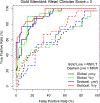Clinicians' Use of Quantitative Information When Assessing the Rate of Structural Progression in Glaucoma
- PMID: 35144008
- PMCID: PMC9357231
- DOI: 10.1016/j.ogla.2022.02.001
Clinicians' Use of Quantitative Information When Assessing the Rate of Structural Progression in Glaucoma
Abstract
Purpose: OCT scans contain large amounts of information, but clinicians often rely on reported layer thicknesses when assessing the rate of glaucomatous progression. We sought to determine which of these quantifications most closely relate to the subjective assessment of glaucoma experts who had all the diagnostic information available.
Design: Prospective cohort study.
Participants: Eleven glaucoma specialists independently scored the rate of structural progression from a series of 5 biannual clinical OCT printouts.
Methods: A total of 100 glaucoma or glaucoma suspect eyes of 51 participants were included; 20 were scored twice to assess repeatability. Scores ranged from 1 (improvement) to 7 (very rapid progression). Generalized estimating equation linear models were used to predict the mean clinician score from the rates of change of retinal nerve fiber layer thickness (RNFLT) or minimum rim width (MRW) globally or in the most rapidly thinning of the 6 sectors.
Main outcome measures: The correlation between the objective rates of change and the average of the 11 clinicians' scores.
Results: Average RNFLT within the series of study eyes was 79.3 μm (range, 41.4-126.6). Some 95% of individual clinician scores varied by ≤ 1 point when repeated. The mean clinician score was more strongly correlated with the rate of change of RNFLT in the most rapidly changing sector in %/year (pseudo-R2 = 0.657) than the rate of global RNFLT (0.372). The rate of MRW in the most rapidly changing sector had pseudo-R2 = 0.149.
Conclusions: The rate of change of RNFLT in the most rapidly changing sector predicted experts' assessment of the rate of structural progression better than global rates or MRW. Sectoral rates may be a useful addition to current clinical printouts.
Keywords: Clinical care; Diagnostic testing; OCT; Survey.
Copyright © 2022 American Academy of Ophthalmology. Published by Elsevier Inc. All rights reserved.
Figures




References
Publication types
MeSH terms
Grants and funding
LinkOut - more resources
Full Text Sources
Medical

